英文文摘
专业英语--产品介绍
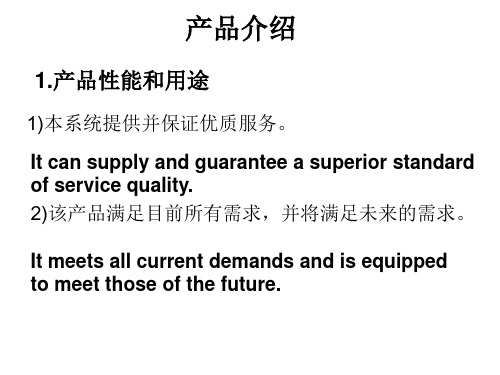
c.Press the INV key and you can raise the constant e (2.7182818) to x powers.
(4)选择合适的翻译技巧遣词造句,重述原文内容; a. Internet is of great help to our work. b.Mankind has always reverenced what Tennyson call “the useful trouble of the rain”.
4)后置定语很常见; The connecting rod, in essence, is a bar or strut with a bearing at each end, whose purpose is to transmit the piston thrust to the crankshaft. 5)名词连用 a. computer programming teaching device manual
What are the chances of a nuclear war in the near future? How many Americans would survive a nuclear attack? Would such an attack make living conditions impossible for the survivors? These and similar questions are being asked by citizens groups throughout this country as they debate the issue of arms control and nuclear disarmament.
英语文献检索常用词及其缩写

英语文献检索常用词及其缩写(整理者:浙大宁波理工学院图书馆王建涛)英文全称缩写中文Abstracts Abstr 文摘Abbreviation 缩语和略语Acta 学报Advances 进展Annals Anna. 纪事Annual Annu. 年鉴,年度Semi-Annual 半年度Annual Review 年评Appendix Appx 附录Archives 文献集Association Assn 协会Author 作者Bibliography 书目,题录Biological Abstract BA 生物学文摘Bulletin 通报,公告Chemical Abstract CA 化学文摘Citation Cit 引文,题录Classification 分类,分类表College Coll. 学会,学院Compact Disc-Read Only Memory CD-ROM 只读光盘Company Co. 公司Content 目次Co-term 配合词,共同词Cross-references 相互参见Digest 辑要,文摘Directory 名录,指南Dissertations Diss. 学位论文Edition Ed. 版次Editor Ed. 编者、编辑Excerpta Medica EM 荷兰《医学文摘》Encyclopedia 百科全书The Engineering Index Ei 工程索引Et al 等等英文全称缩写中文European Patent ConvertionEPC 欧洲专利协定Federation 联合会Gazette 报,公报Guide 指南Handbook 手册Heading 标题词Illustration Illus. 插图Index 索引Cumulative Index 累积索引Index Medicus IM 医学索引Institute Inst. 学会、研究所International PatentClassification IPC 国际专利分类法International Standard BookNumber ISBN 国际标准书号International Standard SeriesNumber ISSN 国际标准刊号Journal J. 杂志、刊Issue 期(次)Keyword 关键词Letter Let. 通讯、读者来信List 目录、一览表Manual 手册Medical Literature Analysisand MADLARS 医学文献分析与检索系统Retrieval SystemMedical Subject HeadingsMeSH 医学主题词表Note 札记Papers 论文Patent Cooperation TreatyPCT 国际专利合作条约Precision Ratio 查准率Press 出版社英文全称缩写中文Procceedings Proc. 会报、会议录Progress 进展Publication Publ. 出版物Recall Ratio 查全率Record 记录、记事Report 报告、报导Review 评论、综述Sciences Abstracts SA 科学文摘Section Sec. 部分、辑、分册See also 参见Selective Dissemination ofInformation SDI 定题服务Seminars 专家讨论会文集Series Ser. 丛书、辑Society 学会Source 来源、出处Subheadings 副主题词Stop term 禁用词Subject 主题Summary 提要Supplement Suppl. 附刊、增刊Survey 概览Symposium Symp. 专题学术讨论会Thesaurus 叙词表、词库Title 篇名、刊名、题目Topics 论题、主题Transactions 汇报、汇刊V olume Vol. 卷World Intellectual PropertyOrganization WIPO 世界知识产权World Patent Index WPI 世界专利索引Yearbook 年鉴(整理者:王建涛;来源:/xxjs/index.php/%E4%BF%A1%E6%81%AF%E6%A3%80%E7%B4%A2%E5%B8 %B8%E7%94%A8%E8%8B%B1%E6%96%87%E8%AF%8D%E5%8F%8A%E7%BC%A9%E5%86 %99%E8%8B%B1%E6%B1%89%E5%AF%B9%E7%85%A7)。
完整英文摘要

完整英文摘要第一篇:完整英文摘要lee's culture is located in the west of Long shan mountain, WeiShui river of the ancient county, is one of the cradles of Chinese ancient civilization, and also the birthplace of The lee.With Dunhuang culture, Tianshui fuxi culture, LaBuLengSi Tibetan Buddhism culture is one of four culture of Gansu province.But at present, the cultural development of West gansu is lagging behind, a lot of development and utilization of resources is difficult to get, it has to do withWest gansu geographical position relatively closed, human resources development has a close relationship.Lee's culture as an important form about culture, also suffered a bottleneck in its development, lee's cultural history and contemporary development not well together, especially in the promotion and development of invested is not enough, lead to lee's culture has been difficult to familiar to the general public.Local economic backward culture is difficult to promote the development process.Fully realize the importance of West gansu lee culture, reasonable and effective development of lee's culture, make its internal value have spread wider, deeper reach to culture to promote economic and cultural development dual goal.Cultural characteristicscountermeasuresThe economicdevelopment第二篇:摘要英文摘要温度是生产过程中常见和重要的物理参数。
摘要英文范文

英语论文摘要seems like we need to do some copy plus translation work.the differences in manners and customs between Chinese and western cultures.done. run your spell check please. I didnt pay any attention about spelling and the numbers of words while typing. add some words of your major couses.good luck and best wishes.英文摘要格式主要纲目以大写罗马数字标出,次要纲目则依次用大写英文字母、阿拉伯数字和小写英文字母标出。
各数字或字母后均为一句点,空出一格后再打该项内容的第一个字母;处于同一等级的纲目,其上下行左边必须对齐。
需要注意的是,同等重要的纲目必须是两个以上,即:有Ⅰ应有Ⅱ,有A应有B,以此类推。
如果英文论文提纲较长,需两页纸,则第二页须在右上角用小写罗马数字标出页码,即ii(第一页无需标页码)。
三、摘要1、英文摘要是应用符合英文语法的文字语言,提供论文内容梗概为目的的短文。
(内容基本与中文摘要相同,但不用完全逐句对应)。
2、英文题目、摘要、关键词自成一页(1页即可),放在中文摘要页之后。
3、英文字体与行间距:统一使用“西文字体”中的“Times New Roman”,1.5倍行间距。
4、英文题目:使用三号字加粗。
5、英文摘要:“Absract”顶格,使用四号字,并加粗。
6、英文关键词:“Key Words”顶格,使用四号字并加粗。
四、正文有标题页和提纲页的英语论文,其正文第一页的规范格式为:论文标题居中,其位置距打印纸顶端约5cm,距正文第一行约1.5cm。
在打印正文时尚需注意标点符号的打印格式,即:句末号(句号、问号及感叹号)后应空两格,其他标点符号后则空一格。
英语文摘精选5篇

英语文摘精选5篇如果能够抄之前先好好读读,并且理解其意思,然后再抄完了之后是不是翻阅自己的摘抄本,那么效果又会更进一步!今天小编在这给大家整理了英语文摘大全,接下来随着小编一起来看看吧!英语文摘(一)给你一篇小情书You’re the one, It was you all the time.你一直都是我的最爱。
I love everything about you, except the fact that youre not with me.我爱你的一切,可事实是你并不爱我。
I wish that you were here or I were there or me and you we anywhere together..多么希望我们此刻能够紧紧相依。
I know its too much to ask for you to think of me as much as I think of you but I just hope that someday, somehow, you think of me too.但愿你哪天也会很想念我,正如我想念你一般。
My heart wont let you go, and I need you to know, I miss you. 我不舍得你离开我,我只想告诉你,我很想你。
When I miss you, I dont have to go far...I just have to look inside my heart because thats where Ill find you.其实,我的心里一直都有你。
Im waiting and hoping, and wishing for the time when we can be together again... I miss you so much.我等待着,期盼着,我们可以再次重逢,而你会重新爱上我…Even though we are far apart you will always be in my little heart.哪怕相距千里,你也依旧在我心里。
英语文摘精选5篇

英语文摘精选5篇如果能够抄之前先好好读读,并且理解其意思,然后再抄完了之后是不是翻阅自己的摘抄本,那么效果又会更进一步!今天小编在这给大家整理了英语文摘大全,接下来随着小编一起来看看吧!英语文摘(一)给你一篇小情书You’re the one, It was you all the time.你一直都是我的最爱。
I love everything about you, except the fact that you're not with me.我爱你的一切,可事实是你并不爱我。
I wish that you were here or I were there or me and you we anywhere together..多么希望我们此刻能够紧紧相依。
I know it's too much to ask for you to think of me as much as I think of you but I just hope that someday, somehow, you think of me too.但愿你哪天也会很想念我,正如我想念你一般。
My heart won't let you go, and I need you to know, I miss you.我不舍得你离开我,我只想告诉你,我很想你。
When I miss you, I don't have to go far...I just have to look inside my heart because that's where I'll find you.其实,我的心里一直都有你。
I'm waiting and hoping, and wishing for the time when we can be together again... I miss you so much.我等待着,期盼着,我们可以再次重逢,而你会重新爱上我…Even though we are far apart you will always be in my little heart.哪怕相距千里,你也依旧在我心里。
英文摘要的写法
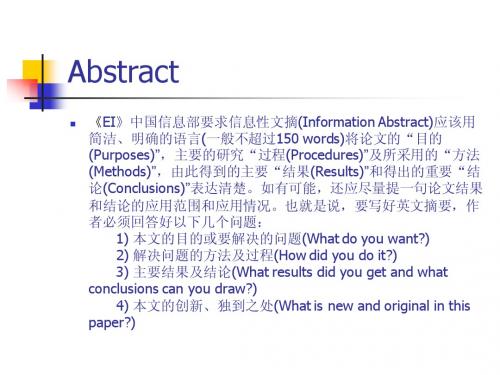
主要结论
The results indicated that … The results show that … The results demonstrated that … The results reveal that …
由It 引起的that 从句 It was shown that … It can be seen that … It was found that … It was discovered that … It was concluded that … It has been demonstrated that It was clarified that … It was revealed that … It is considered that … It was confirmed that … It is suggested that … It was supposed that … It has become apparent that …
2、过程与方法(How did you do it?) 过程及方法。主要说明作者主要工作过程及所用的方法,也 应包括众多的边界条件,使用的主要设备和仪器。在英文摘要中, 过程与方法的阐述起着承前启后的作用。开头交待了要解决的问 题(What do you want )之后,接着要回答的自然就是如何解决问 题(How did you do),而且,最后的结果和结论也往往与研究过 程及方法是密切相关的。大多数作者在阐述过程与方法时,最常 见的问题是泛泛而谈、空洞无物,只有定性的描述,使读者很难 清楚地了解论文中解决问题的过程和方法。因此,在说明过程与 方法时,应结合(指向)论文中的公式、实验框图等来进行阐述, 这样可以既给读者一个清晰的思路,又给那些看不懂中文(但却可 以看懂公式、图、表等)的英文读者以一种可信的感觉。
生活词汇(读者文摘英文版)
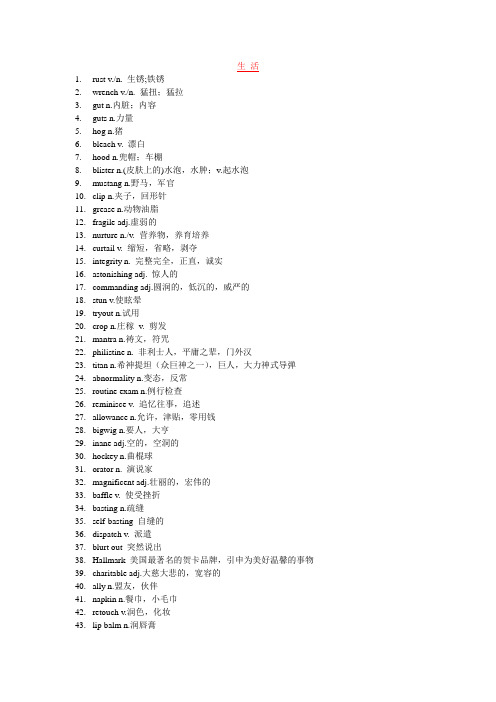
生活1.rust v./n. 生锈;铁锈2.wrench v./n. 猛扭;猛拉3.gut n.内脏;内容4.guts n.力量5.hog n.猪6.bleach v. 漂白7.hood n.兜帽;车棚8.blister n.(皮肤上的)水泡,水肿;v.起水泡9.mustang n.野马,军官10.clip n.夹子,回形针11.grease n.动物油脂12.fragile adj.虚弱的13.nurture n./v. 营养物,养育培养14.curtail v. 缩短,省略,剥夺15.integrity n. 完整完全,正直,诚实16.astonishing adj. 惊人的manding adj.圆润的,低沉的,威严的18.stun v.使眩晕19.tryout n.试用20.crop n.庄稼v. 剪发21.mantra n.祷文,符咒22.philistine n. 非利士人,平庸之辈,门外汉23.titan n.希神提坦(众巨神之一),巨人,大力神式导弹24.abnormality n.变态,反常25.routine exam n.例行检查26.reminisce v. 追忆往事,追述27.allowance n.允许,津贴,零用钱28.bigwig n.要人,大亨29.inane adj.空的,空洞的30.hockey n.曲棍球31.orator n. 演说家32.magnificent adj.壮丽的,宏伟的33.baffle v. 使受挫折34.basting n.疏缝35.self-basting 自缝的36.dispatch v. 派遣37.blurt out 突然说出38.Hallmark 美国最著名的贺卡品牌,引申为美好温馨的事物39.charitable adj.大慈大悲的,宽容的40.ally n.盟友,伙伴41.napkin n.餐巾,小毛巾42.retouch v.润色,化妆43.lip balm n.润唇膏44.Foam [fəum] n. 泡沫, 水沫v. 起泡沫45.Luxury ['lʌkʃəri] n. 奢侈,豪华46.Thrill [θril] n. 震颤, 激动v. 震颤,抖颤,激动47.Toss [tɔs] n. 投掷, 震荡v. 投掷,摇荡,辗转48.Ingredient [in'gri:diənt] n. 成分,因素49.Inactive [in'æktiv] adj. 不活动的,停止的,怠惰的[计算机] 不活动的50.Moderation [.mɔdə'reiʃən] n. 缓和,适度,温和51.Margarine [mɑ:dʒə'ri:n, 'mɑ:gərin] n. 人造黄油52.trans fat [trasfat] 反型脂肪53.peppermint ['pepəmint] n. 薄荷,薄荷糖,薄荷味54.soothe [su:ð] v. 缓和,使...安静,安慰55.indigestion [.indi'dʒestʃən] n. 消化不良56.disarming [dis'ɑ:miŋ] adj. 使人松驰的57.berth [bə:θ] n. 停泊处,睡床58.reciprocal [ri'siprəkəl] adj. 相互的,互惠的59.deliberately [di'libərətli] adv. 故意地60.recipient [ri'sipiənt] n. 接受者,收信人61.intimidating [in'timideitiŋ] adj. 给人以威胁的,咄咄逼人的62.lobby ['lɔbi] n. 大厅,门廊,门厅,休息室,游说议员者63.expire [iks'paiə, eks-] v. 期满,失效,终止,断气64.mentor ['mentɔ:] n. 指导者65.intake ['inteik] n. 引入口,入口,通风口66.binge [bindʒ] n. 狂闹67.Dose [dəus] n. 剂量, 服用量v. 配68.texture ['tekstʃə] n. (材料等的)结构,质地69.gnarly ['nɑ:li] adj. 扭曲的(粗糙的,多瘤节的)70.Fete [feit] n. 庆祝, 祭祀, 节日v. 宴请,招待71.beget [bi'get] v. 产生, 引起vt. 产生,生(子女)72.dumb [dʌm] adj. 无言的,哑的73.sadden ['sædn] vt. 使...黯淡(使...悲伤)74.predator ['predətə] n. 食肉动物75.courtesy ['kə:tisi, 'kɔ:-] n. 礼貌,好意76.assortment [ə'sɔ:tmənt] n. 分类,配合,各色俱备之物77.intimidating [in'timideitiŋ] adj. 给人以威胁的,咄咄逼人的78.cyberspace ['saibəspeis] 电脑空间79.catchword ['kætʃwɜ:d] n. 口号,标语,(字典等每页上端的)标字80.fluid ['flu(:)id] adj. 流体的,流动的n. 流体,液体81.dedicate ['dedikeit] v. 献出82.tousle-haired 头发杂乱的83.pathos ['peiθɔs] n. 感伤,悲怅,悲情84.overlay [.əuvə'lei] 覆盖85.snatch [snætʃ] n. 抢夺,碎片,一阵v. 夺取,想抢走,侥幸获得86.ancestral [æn'sestrəl] adj. 祖先的,祖传的87.forger ['fɔ:dʒə(r)] n. 伪造者,膺造者,铁匠88.surveillance [sə:'veiləns] n. 监视,监督89.acquit [ə'kwit] v. 开释,释放,行为90.provoke [prə'vəuk] v. 激怒,惹起,驱使91.drain [drein] n. 下水道,排水沟,消耗v. 耗尽,排出沟外92.vested ['vestid] v. 穿衣服(授予)adj. 既得的(法律规定的)93.penalty ['penlti] n. 处罚,惩罚94.mattress ['mætris] n. 床垫95.startled ['stɑ:tld] v. 震惊vbl. 震惊96.underprivileged ['ʌndə'privilidʒd] adj. 贫穷的97.carnival ['kɑ:nivəl] n. 嘉年华会,狂欢节,饮晏狂欢passion [kəm'pæʃən] n. 同情,怜悯99.empathy ['empəθi] n. 移情作用, [心]神入100.charitable ['tʃæritəbl] adj. 仁慈的, (为)慈善事业的,宽恕的101.bunk [bʌŋk] n. 铺位(座床,床铺)vt 为...提供卧铺102.dreary ['driəri] adj. 沉闷的103.philanthropy [fi'lænθrəpi] n. 博爱主义,慈善事业,善心104.alleviate [ə'li:vieit] v. 减轻,使...缓和105.capture ['kæptʃə] n. 抓取,战利品,捕获之物v. 抓取,获得,迷住106.vulnerable ['vʌlnərəb(ə)l] adj. 易受伤害的,有弱点的107.Nourish v.养育培养108.Coddle v.用文水煮,细心照料109.Frugality n.节俭,节约110.Scam n.诡计阴谋111.Fraudulent a.欺骗性的112.Mimic a.模拟的,假的113.Trooper n.骑兵,骑摩托车警察114.Range n.巡警115.Recruit v.招聘,招募116.Downsize v.缩小规模,精简117.Planetarium n.天文馆,天象图118.Cardigan n.开身毛衣119.Merriment n.联欢会,喜庆活动120.Knack n.窍门,技能121.Gut n.内脏/a.直觉的122.Legacy n.遗产123.Cascade n.小瀑布124.Crane n.吊车,起重机125.Ordeal n.苦难,煎熬126.Trauma n.损伤,外伤127.Shawl n. 方形披肩128.Seed money(用来吸引更多资金的)种子基金129.Heimlich maneuver 海姆利克氏操作法(手推哽咽着的上腹部,以逼出气管中的异物)130.Flip-flop 啪嗒啪嗒的拍131.Guardrail n.护栏,护轨132.Slump v. (物价)暴跌,(市场)萧条133.Windscreen n.挡风玻璃134.Skid n.刹车135.Chaperone n. 青年社交集会)陪伴监护人136.Fracture n.骨折137.Propagate v.繁殖,遗传138.Naysayer n.拒绝者,否认者139.Perennial a.长年的,终年的140.Offset n.分支,旁系141.Hoarder n.贮藏者,囤积者142.Crust n.面包皮,硬的外壳143.Beget v.为...之生父,产生,引起144.Berth n.停泊位,回旋的余地145.Grump n.发火/v.闹情绪146.Arbitrary a.任意的,专横的147.Eyeball n.眼球/v.盯住,观察148.Icon n.偶像,图符149.Strife n.冲突,倾轧150.Housekeeper主妇,女管家151.Joke笑话,玩笑,可笑的人事物,情形152.Love 爱,热爱153.Servant 仆人,用人154.Hands-off 闲的155.Celebrate 庆祝,赞美,歌颂156.Sex性,性别,性行为157.Drug麻醉药,毒品158.Money钱,金钱,财富159.Drinking 喝酒160.Marijuana大麻161.Cocaine可卡因162.Gambling赌博163.Mortgage抵押借款164.Stagger蹒跚165.Debt债务166.Swindle诈骗,骗取钱财167.Cannibal食人者168.Breathe呼吸169.Copd (chronic obstructive pulmonary disease) 170.Smoking吸烟171.Sponsor赞助,发起172.Wedding婚礼173.Mutual相互的,彼此的,共有的174.Penalty惩罚,处罚175.Forgiveness原谅176.Etiquette 礼节,礼仪177.Acquaintance熟人,相识的人178.Booze酒,烈性酒179.Wino酒鬼180.Hint暗示示意181.Manner 方式,方法,礼貌,态度182.Parent父母183.Heartburn胃痛184.Diet日常饮食185.Joy欢乐,快乐promise妥协,折中方法187.cherish珍惜188.gleeful愉快的,极高兴的189.Family家庭190.auspicious吉祥的,有前途,有希望的191.miracle奇迹192.helper助手193.resonate(使)共鸣,(使)共振194.outrageous骇人的,残暴的,无耻的195.Make sb laugh使某人发笑196.Fat cat 有权有势的人197.Air force one 空军一号,美国总统专机198.Get married 结婚199.Throw a dinner举办宴会200.Postage stamps 邮票201.Play golf 打高尔夫球202.Pull sb’s life back救命203.a life of hard labor艰苦的生活204.Life style 生活方式205.stick to a plan 坚持计划206.a self-deprecating laugh自嘲207.break down打破,制服,故障208.take advantage of利用,趁……之机209.a sudden windfall横财210.pay off debt偿还债务211.play with玩212.make sb feel at home随意213.go off爆炸,进行,被发射214.be proud of自豪215.grow up成长,长大216.生活:217.Nourish v. 滋养, 使...健壮, 怀有218.Fragrance香味219.Reservoir n. 贮水池, 贮藏处, 贮备220.Trivia n. 琐事221.Calorie n. 卡(热量单位)222.Calculator n. 计算器223.Brunch n. 早午餐224.Cinnamon n. 肉桂, 肉桂树, 肉桂色adj. 肉桂色, 黄褐色的225.Veterinarian n. 兽医226.Osteoporosis n. 骨质疏松症227.Fracture n. 破碎, 骨折v. 破碎, 破裂228.Hip n. 臀部,229.Spine n. 背骨, 脊柱, 尖刺230.Calcium n. 钙231.Allergic adj. 过敏的232.Fluid .流体的,流动的n. 流体,液体233.Dental 牙齿的,牙科的234.Ravish 迷住,强夺235.Amputee 受切断手术的人236.Upbeat n. 上升adj. 乐观的237.Sideline n. (球场) 边线rry n 薄浆(拌浆锄,手推车) vt 灌薄浆239.Registry. 记入,登记,登记名册240.Moniker n 名字, 绰号241.Contestant n. 竞争者242.Plaque n 匾,饰板,名牌,徽章243.Coupon n 试样(配给票,息票,附单)244.Heroism n. 英勇, 勇敢的事迹, 豪侠的行为245.Antiwar adj. 反战的undry n. 洗衣店, 要洗的衣服, 洗衣247.Proxy n. 代理, 代理人, 取代物248.Scam n. 诡计, 故事249.Liar n. 说谎者250.Drowsy adj. 昏昏欲睡的251.Log n. 记录, 圆木, 日志252.Pedometer n. 步数计, 步程计253.Derail v. 使出轨254.Balsamic adj 香膏质的,如香油的,镇静的255.Prodigy n. 惊人的事物, 不凡的人,256.Riddle n. 谜, 谜语v. 解谜,出谜题257.Bagel 百吉圈面包258.Puff V. 吸(烟)259.Bounty 慷慨之举;大量给予之物;奖金260.Naught = nought 0(数码)零,无come to naught 付诸东流261.Scree 碎石坡;岩屑堆262.Bigotry 顽固盲从;偏执263.Tequila 龙舌兰酒264.Consume sb. 使充满(强烈的感情)265.Rail 怒斥;责骂;抱怨266.Rambunctious = rumbustious =boisterous 吵闹的;喧闹的267.Ironing 熨烫268.Subdue 制伏;抑制;克制(感情)269.Aptitude 天资270.Pantry 视频贮藏室271.Stroll 散步;溜达;闲逛272.Trimmer 花草等的修降机;a hedge trimmer 树篱修剪机273.Arbor 凉棚;棚架274.pergola['pə:gələ]n. 棚架,凉棚275.Shady 背阴的;阴凉的276.Chickpeas 鹰嘴豆277.Trowel 小铲子;瓦刀278.62Cleat 小木桩;金属桩;防滑钉279.Velcro 维可牢搭扣;尼龙搭扣;魔术贴280.64.drupe[dru:p]n. 核果281.65.bonsai['bɔnsai]n. 盆栽,盆景282.66.bistro小酒馆283.ikebana['i:ke'bɑ:nɑ:]n. 插花(术),花道284.drain: n.下水道,排水沟,消耗v.耗尽,排出沟外285.reservoir: ['rezəvwɑ:] n. 水库,蓄水池286.cinnamon mocha coffee: 摩卡咖啡287.gadget : n. 小机件288.asparagus: [ə'spærəgəs] n. 芦笋289.veterinarian: [.vetəri'nɛəriən] n. 兽医290.osteoporosis: [.ɔstiəupɔ:'rəusis] n. 骨质疏松症291..aisle: n. (席位间的)通道292.faculty: ['fækəlti] n. 才能,能力,全体教员n. (大学的)系, 科, 院293.excerpt: ['eksə:pt] n. 摘录v. 摘录,摘要294.menopause:更年期295.gorgeous: adj. 华丽的,灿烂的,好极了296.ace: n. 好手,高手adj. 一流的,卓越的297.leash: n. (系狗的)皮带;控制,约束v.束缚298.Powerball tickets: 强力球(美国的全国性彩票)299.exonerate: [ig'zɔnəreit] v. 免除责任,确定无罪vt. 使免罪300.daze: v. 使...茫然301.lieutenant: [lju:'tenənt] n. 中尉,助理人员,副官302.colonel: [kəʊ'ləʊn] n. 冒号303.amputate: v. 切断304.brag: n. 吹牛v. 吹牛305.erupt: [i'rʌpt] v. 爆发306.ovation: n. 热烈欢迎,大喝采,大受欢迎307.subzero: adj. 零下的(负的)308.intercept: n. 截取,妨碍,截距v. 拦截,阻止,截取309.rehab: ['ri:hæb] vt. 修复(整顿,恢复)310.prosthetic: adj. 弥补性的311.upbeat: n. 上升adj. 乐观的312.battalion: [bə'tæljən] n. 营,军队,集团313.nix: n.无,皆无v. 禁止,拒绝314.moniker: n. 名字, 绰号315.nary: ['nɛəri] adj. 连...也没有的316.irate: [ai'reit] adj. 发怒的,生气317.bathtub: n. 浴缸318.harrowing: adj. 悲痛的,难受的319.dollop: n. 块320.dodge: v. 避开,躲避321.pretzel: n. 一种脆饼干322.ominous: ['ɔminəs] adj. 预兆的,不祥的323.ford: n. 浅滩v.涉过,涉水324.guerrilla: [gə'rilə] n. 游击队员325.anthem: n. 圣歌,赞美诗326.Americanized: v. 使...美国化327.lottery: n. 彩票328.handful: n. 少数,一把,棘手之事329.malady ['mælədi]n. 病,疾病,弊病330.residue ['rezidju:] n.残余[渣]余款331.tot 幼儿: a TV program for tiny tots 为幼儿看的电视332.lengthy ['leŋθi] adj. 冗长的,漫长的333.malady ['mælədi] n. 病,疾病,弊病334.lobby ['lɔbi] n. 大厅, ,休息室,游说议员者v. 游说335.malady ['mælədi] n. 病,疾病,弊病336.jaundice ['dʒɔ:ndis] n. 黄疸,偏见,乖僻337.icket ['rikit] n. <俚>(黑社会用语)失风,大错338.egacy ['legəsi] n. 祖先传下来之物,遗赠物339.hardscrabble ['hɑ:d'skræbl] [美]贫脊的非常穷困的340.nomadic [nəu'mædik] adj. 游牧的,游牧民族的,流浪的341.dumpster n. 垃圾大铁桶342.cabby ['kæbi] n. 计程车司机,出租马车的车夫343.fraud [frɔ:d] n. 骗子,欺骗,诈欺344.flush [flʌʃ] n. 流溢,面红,旺盛adj. 丰足的,齐平的,满盈的v. 脸发红,淹没,旺盛345.shelve [ʃelv] v. 搁置346.inconsequential [in.kɔnsi'kwenʃəl] adj. 不合逻辑的,不合理的,不重要的347.coax [kəuks] v. 哄,诱骗,灵巧慢慢的做348.acclaim [ə'kleim] n. 喝采,欢呼,赞同v. 欢呼, 称赞349.auctioneer [.ɔ:kʃə'niə] n. 拍卖商350.predominantly [pri'dɔminəntli] adv. 优越地,卓越地,主要地351.detach [di'tætʃ] v. 分离[计算机] 脱离352.slap [slæp] n. 掴,侮辱,拍击声a)v. 拍击,侮辱,申斥adv. 正面地,直接地,突然地353.canvas ['kænvəs] n. 帆布354.refine [ri'fain] v. 精炼,净化,使优雅355.retrospection [retrə'spekʃ(ə)n] n. 回顾,追忆,考虑pulsion [kəm'pʌlʃ(ə)n] n. 强迫,强制357.scenario [si'nɑ:riəu] n. 情节,剧本358.encapsulate [in'kæpsjuleit] v. 装入胶囊,封进内部,压缩359.therein [ðɛər'in] adv. 在其中,在那里,在那一点上360.therapeutic [θerə'pju:tik] adj. 治疗的361.ponder ['pɔndə] v. 沉思,考虑362.quilt [kwilt] n. 被子363.residual [ri'zidjuəl] adj. 残余的,剩余的364.blockbuster ['blɔk.bʌstə] n. 轰动,巨型炸弹365.chronical ['krɔnikɚl] adj. 长期的,慢性的366.Serum 血清367.strand 股,缕(线绳毛发等)368.stash 贮藏,存放369.nursing 护理,看护370.triage 患者或伤者鉴别分类371.foreclosure 取消抵押品赎回权372.fascinating 吸引人的有趣的373.memoir (尤指名人的)回忆录自传374.solar-powered 太阳能的375.devious 不诚实的,欺诈的376.immortality 永生,不朽,不灭377.lobby 游说团体378.splurge 挥霍379.runaway 失控的380.entrepreneur 企业家,创业者381.dye 染料,染色382.residue 残留物,残渣383.snapshot (尤指抢拍的)照片384.affordable买得起的,付得起的385.sweeptake 赌金全赢制386.bonus 奖金,津贴,红利387.pounce 猛扑,突袭388.leap 跳跃389.vitality 生命,活力390.dedicated 专心致志的,专门用途的391.reimburse 补偿,偿还392.facial 面部护理,美容393.liability 责任,义务394.spare 备用品(通常指备用轮胎)395.premium 保险费396.mortgage 按揭贷款397.manual 指南,说明手册398.pragmatic 使用的,讲求实效的399.synagogue 犹太教堂400.cooker厨具401.longevity 长寿,长命402.antidote 解毒药,解毒剂403.mucus 粘液,鼻涕404.Grouse = grumble 抱怨,发牢骚405.Ignite (使)燃烧;着火;点燃406.Inebriated =drunk 喝醉的407.Smolder (无名火地)阴燃,闷燃;(感情)郁积,压在心头408.Squint 眯着眼睛看,斜视409.Well-heeled = well-to-do 有钱的,富有的410.Ballad 叙事诗,民歌,民谣411.Biscuit 小饼干l 磨坊,面粉厂;工厂413.Ranch 大牧场;大农场414.Mutt 小狗;野狗;杂种狗415.toenail n脚趾甲, 斜钉下去的钉子416.bubble gum n. <美>泡泡糖417.tactic n策略, 战略 adj.按顺序的, 排列的418.exhale v.呼气, 发出, 发散, <古>使蒸发419.spine n.脊骨, 书脊, 地面隆起地带, 中心, 剌420.hazelnut n.榛实421.almond n.[植]杏树, 杏仁, 杏仁壮物422.walnut n.胡桃, 胡桃木423.strategize vi.制订战略[行动计划]vt. 为…制订战略[行动计划] 424.wear down v.磨损, 损耗, 使疲劳, 使厌烦, 克服425.beer belly n.大肚子426.tuna n.金枪鱼427.flaxseed n.亚麻子, 亚麻仁flaxseed428.toxin n. [生化][生]毒素429.mercury n.水银, 汞430.FDA abbr. Food and Drug Administration (美国)食品及药物管理局431.anthocyanin n. [植]花青素432.dilate vi.扩大, 详述, 膨胀 vt.使扩大, 使膨胀433.artery n.动脉, 要道434.cocoa n.可可粉, 可可饮料, 可可豆435.dementia n. [医] 痴呆436.prescription n.指示, 规定, 命令, 处方, 药方437.pistol n.手枪438.wacky adj. <美俚>古怪的, 乖僻的, 疯疯癫癫的439.vending machine n.自动贩卖机440.start-up n.启动441.exotic adj.异国情调的, 外来的, 奇异的442.Trappistine n.[宗](天主教西多会中的)特拉普派修女443.creamy adj.含乳脂的, 奶油色的, 乳脂状的444.caramel n.焦糖, 饴糖445.nun n.修女, 尼姑446.syrup n.糖浆, 果汁447.chicken out [美俚]因害怕而停止做某事, 因胆小而放弃448.chicken pox n. [医]水痘449.risqué adj. <法> (作品等)淫秽的, 败坏风俗的450.darn n. v.织补451.soundtrack n. 声道;音带;声迹452.premiere v.初次公演, 初演主角 n.初次的演出 adj.突出的, 杰出的453.nagging adj.唠叨的, 挑剔的n.唠叨, 挑剔454.bounce off (1)试探(某人对某一新设想和意见) (2)大发议论455.petunia n. [植]矮牵牛花456.pansy n. [植]三色紫罗兰457.spade n.铲, 铁锹v.铲458.gambit n.以优势的开局棋法, 话题, 开始459.bistro n.<俗>小酒馆, 小咖啡店, 酒馆跑堂者460.flirt vi.调情, 摇晃的移动, 玩弄, 摇晃地摆动, 轻率地对待 n.卖弄风情的人, 调情的人461.Frisbee n.飞盘462.barkeep n. <美>酒吧间老板酒吧间招待463.behold vt.把...视为 vi.看464.slump n.消沉, 衰退, (物价)暴跌 v.失败, 消沉, (物价)暴跌, 跌落465.whine n.抱怨, 牢骚, 哀鸣 vi.报怨声, 哭诉, 发牢骚, 发呜呜声vt..哀诉466.impulsive adj.冲动的467.sip v.吸吮468.fruity adj.果味的, (酒)有葡萄味的, (声音)洪亮的469.woe n.悲哀470.wail n.悲叹, 哀号, 痛快 vi.悲叹, 哀号, 嚎啕 vt..悲痛(某人的悲惨遭遇)471.boredom n.厌倦472.rug 地毯473.stretch 拉伸474.unruly 不守规矩地475.heel 足跟476.bounce 反弹477.loop 环478.limber准备活动479.scramble 爬行,攀爬480.spur (山的)支脉,山鼻子481.trail (荒野中踏成的)小道482.summit 山峰尖锋483.scrap 将...作为废物;将...拆毁484.precipice 断崖,绝壁危急的处境;灾难的边缘485.slam 砰地放下(或放倒)486.feetfirst 脚先着地(水)地487.stun 把...打昏,使昏迷488.wiggle 摆动;扭动489.echo 回声;回响490.canyon (既长又深,谷底常有溪流的)峡谷491.pelvis 骨盆492.vertebrae 椎骨493.shatter 粉碎,砸碎494.huddle 1. 挤作一团;聚在一起2. 蜷缩,缩成一团3. 偎依495.stroke (用手)抚,摸,捋496.subside 退落;消退;消失497.block (四面围有街道的)街区498.trot (马等的)小跑,快步499.bruise 伤痕,青肿500.fabric 织物,织品;布料501.outfit (尤指在特殊场合穿的)全套服装502.flop 扑通落下(或倒下)503.punch 用力击,用力按504.lean 倾身,屈身505.dip 浸;泡506.incredibly 难以置信地;很,极为507.hypothermia 低体温症508.flex 使(肌肉)收缩509.distract 使分心;使转向510.abdomen 腹,下腹;腹部511.swollen 膨胀的;浮肿的512.scoop 用勺舀,用铲子铲513.lid 盖子514.baggy 袋状的;宽松而下垂的515.blend 混合,混杂;交融516.synthetic 合成的,人造的yer 层;阶层;地层518.sip 啜饮519.urinate 撒尿,小便,排尿520.juniper 桧属植物;杜松521.terrain 地面;地域,地带522.gel 胶体;凝胶523.syrup 含药糖浆;单糖浆524.trek (长途而辛苦的)旅行525.knuckle 用指关节敲打(或压,碰等)526.dehydrate 脱水;使干燥527.blanket 毛毯,毯子528.predator 食肉动物;掠夺者529.brutal 残忍的,冷酷的530.nuzzle 用鼻紧挨;用鼻爱抚531.palm 手掌,手心532.duck n.鸭, 野鸭, 母鸭鸭肉亲爱的宝贝, 家伙vt. & vi.忽然低下头(或弯下腰) 533.cop n.警察534.juvenile adj.少年的幼稚的, 年少无知的 n. 青少年扮演少年角色的演员535.detention n.拘留, 扣押536.offender n.冒犯者, 犯规者537.boot camp劳改所538.craze vi.发狂; (陶器)出现裂纹; 微裂n.疯狂; 狂热, 流行(细)裂纹; 裂痕539.overreact vi.反应过度; 互作用过强(to)540.controversy n.(尤指纸上的)论争,论战,辩论法律或财产价值的诉讼vt., vi.争论,辩541.massacre n.残杀; 大屠杀; (牲畜的)成批屠宰专横的解职, 裁员破坏, 毁坏vt.屠杀;残杀乱砍; rowdy adj.好争吵的; 吵闹的542.missteps拥有什么543.concoct vt.将(尤指通常不相配合的)成分混合成某物; 调制编造, 捏造544.implement vt.使生效, 贯彻, 执行n.工具, 器具, 用具545.simplistic adj.过分单纯化的546.harassment n.骚扰, 扰乱547.downcast adj.情绪低落的向下的548.puff n.(呼吸或风的)呼, 吹, 喷(之声) 一缕(烟、蒸汽等) (烟斗或香烟的)一吸, 一口549.pinch vt.盗窃, 偷逮捕, 拘留vt. & vi.捏, 掐, 夹, 拧n.捏, 掐, 夹, 拧一撮, 微量550.expulsion n.喷出, 排出551.bravado n.逞能, 虚张声势vi.作威; 恐吓, 虚张声势552.switchable可有开关控制553.legislator n.立法机关, 立法团体554.intent n.意图, 意向, 目的555.tenacity n.坚韧556.recruit n.新兵(机构中的)新成员vt.招聘; 吸引(新成员)吸收某人为新成员vt. & vi.招募, 征募philanthropist n.博爱慈善活动, 慈善事业557.rigorous adj.严密的; 缜密的558.stunning adj.了不起的, 出色的, 漂亮的令人惊奇的, 令人震惊的559.superintendent n.监管人; 负责人; 主管人警长, 警司560.fluffy adj.似绒毛的, 有绒毛的蓬松的, 松软的561.vanilla n.香子兰; 香草562.litany n.连祷; 启应式祈祷 (英国国教公祷书中的)连祷文唠唠叨叨的抱怨563.pregnancy n.怀孕; 妊娠564.gear n.用具, 设备, 衣服565.mundane adj.平凡的, 平淡的566.broom n.扫扫帚金雀花木桩经打击后裂开的顶端567.divulge vt.泄漏; 揭穿, 暴露(隐私等)[古]公布; 宣布568.cruise vi.乘船巡游n.乘船游览569.breathtakingly adj.激动人心的, 惊人的; 惊险的570.idiosyncratic adj.特殊物质的,特殊的,异质的571.cutlery n.刀具, 刀叉n.刀剑制造[修理、贩卖]业[总称]刀具, 餐具572.etiquette n.礼仪, 礼节573.underdog n.失败者,受压迫者574.tailback n.〈英〉交通堵塞575.storefront n.店面(房), 铺面(房); 临街房576.purveyor n.承办商,伙食承办商577.seamstress n.女裁缝, 做针线活的妇女578.myriad adj.无数的n.无数, 极大数量579.levee n.堤, 堤岸580.sensor n.传感器; 感受[敏感]器敏感元件[装置] 接触元件探测器[设备] 初级检测器581.stack vt. & vi.堆积n.堆, 垛大量, 一大堆582.vent n.(气体、液体等进出的)孔、口 (鸟、鱼、爬行动物或小哺乳动物的)肛门583.renovated重新布置装修修复,革新584.toss vt. & vi.扔; 投; 抛 (使)摇荡; 使颠簸585.garnish n.守备部队, 卫戍部队vt.卫戍部队守备派部队驻防586.angostura [ˌæŋɡɔsˌtjuərə]n.[南美]安哥斯图拉树树皮587.carbonara n.〈意〉烤面条加干酪沙司588.knobby adj.节多的疙瘩多的多丘陵的, 崎岖的 [美俚](服装等)流行的棘手的589.agitated adj.激动的,表现不安的590.Brutal: 残暴的,冷酷的591.Lope: 轻松地大步走592.Endurance : 忍耐力,耐久力593.icle : 交通工具594.nyon : 周围有悬崖峭壁的峡谷595.creek : 小溪596.Coax : 劝诱,哄骗597.Bolt : 跑开,逃跑598.Dash : 急奔,急驰,猛冲599.Sniff : 嗅,闻600.Vanish : 突然消失601.Tempt : 引诱,诱惑602.Biscuit : 饼干p : 舔食,舔着喝604.Spot : 突然看到,发现605.Silt :粉砂,淤泥606.Scoop : 用勺子舀607.Baggy : 宽松的,不紧绷的608.Blend : 混合物,掺合609.Fleece :毛,毛织物610.Synthetic : 人造的611.Curl :蜷缩612.Incredibly : 难以置信的613.Core : 中心部分,最重要的部分614.Hypothermia :体温过低615.Flex : 曲伸活动616.Constant :不断的,连续的617.Crunche :破碎声618.Abdomen :腹部619.Pace :调整自己的工作或活动节奏620.Belly :肚子621.Urinate :排尿,小便622.Juniper :刺柏,桧623.Gel :凝胶,冻胶624.Syrup :糖浆625.Trek :长途跋涉626.Scrape :摩擦627.Crawl :爬行,匍匐前进628.Dehydrate :身体脱水629.Delusion :错觉630.Predator :扑食性动物,掠夺者631.Collar :动物的颈圈632.Brutal :残暴的,冷酷的633.Numb :麻木的,失去直觉的634.Tribute : (尤其指对死者的)颂词,致敬635.Contender :竞争者,角逐者636.Dribble :运球,盘球637.Foray : (改变职业,活动的)尝试638.Lodging :暂时的居住,寄宿,借宿639.Spatula :铲,刮刀,抹刀640.Carousel :机场的行李传送带641.Medieval :中世纪的642.Crew :有专门技术的一组工作人员643.Session :一场,一节,一段时间644.Slam :使。
服饰词汇(读者文摘英文版)

服饰1.ready-made clothes, ready-to-wear clothes成衣2.garments 外衣3.town clothes 外衣4.double-breasted suit 双排扣外衣5.tailored suit 女式西服6.trousseau嫁妆yette 婴儿的全套服装8.overalls 工装裤9.rompers 连背心的背带10.evening dress 夜礼服11.dress coat, tails 燕尾服,礼服12.nightshirt 男式晚礼服13.dinner jacket 无尾礼服)14.full dress uniform 礼服制服15.frock coat 双排扣长礼服16.tunic 长袍17.overcoat 男式大衣18.topcoat 夹大衣19.fur coat 皮大衣20.three-quarter coat 中长大衣21.dust coat 风衣22.poncho 篷却(南美人的一种斗篷)23.sheepskin jacket 羊皮夹克24.pelisse 皮上衣25.jacket 短外衣夹克26.anorak, duffle coat 带兜帽的夹克,带风帽的粗呢大衣27.hood 风帽28.scarf, muffler围巾29.shawl 大披巾30.knitted shawl 头巾,编织的头巾31.fur stole 毛皮长围巾32.muff皮手筒33.housecoat, dressing gown34.short dressing gown 短晨衣35.bathrobe 浴衣36.pyjamas 睡衣裤(美作:pajamas)pel (上衣)翻领38.detachable collar 假领,活领39.wing collar 硬翻领,上浆翻领40.V-neck V型领41.sleeve 袖子42.bathing costume, swimsuit, bathing suit游泳衣43.bikini 比基尼泳衣44.apron 围裙45.pinafore (带护胸)围裙46.shoe鞋47.sole 鞋底48.heel 鞋后跟49.slippers 便鞋50.sandal 凉鞋51.clog 木拖鞋52.galosh, overshoe 套鞋53.bow tie 蝶形领带54.cravat 领巾55.turban 头巾56.natural fabric 天然纤维57.synthetic fabric 混合纤维58.acryl 压克力59.polyester 伸缩尼龙60.tartan plaid格子花61.flower pattern花纹花样62.slim (adj.) 细长的,苗条的(v.) 使变苗条63.wristband (衬衫等的)袖口;表带64.wristband (衬衫等的)袖口;表带65.Denim jacket 粗斜条文上衣66.Suitcase 手提衣箱67.Crust 外壳68.Gnarly 粗糙的69.Tinted 带色彩的70.Dress-for-success suit 精神焕发的着装71.Pearl 珍珠72.Curly hair 卷发73.dopamine n. 多巴胺74.bake v. 烤,烘焙75.oven n. 烤箱,炉76.luscious adj. 美味的,香甜的;迷人的,十分性感的77.toddler n . 小孩78.submission n. 归顺,降服,投降;屈从,服从,顺从79.orphanage n. 孤儿院80.ingredient n . (混合物的)组成部分;配料81.infuse vt. 灌输,加入(一种特性);沏(茶),泡(草药)82.juicy adj. 多汁的;(提供丑闻等消息而)有趣的,富有刺激性的83.gravy n. 肉汁,肉卤84.simmer n. 炖v. 炖,慢煮85.sensational adj. 轰动的,群情激动的;耸人听闻的;极好的,绝妙的86.certified adj. 被鉴定的anic adj. 器官的;有机(体)的,有机物的88.broth n. 肉汤,鱼汤,菜汤89.celery n. 芹菜90.shred n. 碎片,细条,破布;些许,少量v. 撕碎,切碎91.kick v. 踢92.therapeutic adj. 治疗(学)的,疗法的;对身心健康有益的93.stove n . 炉,火炉94.caramel n. (食物着色或调味用的)焦糖95.burger n. 汉堡包96.bacon n. 咸猪肉97.casserole n. 砂锅98.regale v. 宴请,款待;(以笑谈等)娱人99.degeneration n. 变性;退化;恶化;变质100.macular adj. 有斑点的,有污点的101.premium n . 保险费;奖金;额外费用102.remediation n . 补习,辅导,补救,纠正103.risky adj. 危险的,冒险的104.rotten adj. 腐烂的,腐朽的;道德败坏的;极坏的,极讨厌的pulsive adj. 极有趣的,令人着迷的;因着迷而引起的,上瘾的;强迫性的106.futility n. 无益,无用,轻浮的言行107.ascertain v. 弄清,确定,查明108.proponent n. (某事业、理论等的)支持者,拥护者109.contemplate v. 深思,细想,仔细考虑;注视110.raucous adj. 粗声的,沙哑的111.fractious adj. 易怒的,急躁的mercial n. 专题广告片113.surgeon n. 外科医生114.spine n. 脊柱,脊椎;(动植物的)刺,刺毛;书脊115.darn v. 织补(衣物)n. 织补之处116.stereotype n. 老套,模式化的见解,有老一套固定想法的人;vt. 把```模式化,使成陈规117.sequel n. 继之而来的事物;续篇,续集118.premiere v. 初次公演,初次主角n. 初次的公演adj. 杰出的,突出的119.functional adj. 有用的,实用的;能起作用的,产生影响的120.cushion n. 垫子,坐垫121.stiletto n. 细高跟鞋122.cozy adj. 舒适的,安逸的,惬意的123.brownie n . 核仁巧克力饼124.bunkhouse n . 工棚,简易工人宿舍125.sibling n. 兄弟,姐妹126.viticulture n . 葡萄栽培127.vineyard n. 葡萄园128.affiliate vt. 是隶属于,接纳···为成员n .附属企业129.amass vt. 积累,积聚130.rehearse v. 排练,排演;详述131.sculpt v. 雕刻,造型132.flirty 轻浮133.innovative adj. 新发明的,新引进的,革新的,有改革精神的;乐于引进新观念的134.mundane adj. 平凡的,平淡的135.humanitarian n. 人道主义者,博爱主义者,慈善家adj. 人道主义的,博爱的,慈善的136.portfolio n. 公事包,文件夹;投资组合;大臣或部长的职责、职位137.parsley n. 欧芹138.decompose v. (使某物)变坏,腐烂;分解(某物质、光线等)139.allergic adj. 过敏的140.rinse vt. 漂洗,冲洗;用清水漂洗掉(肥皂泡等)n . 漂洗,冲洗;染发剂141.lotion n . 洗液,洗剂,护肤液142.detergent n . 洗涤剂143.renovate vt. 翻新;修复;整修144.fatigue n . 疲劳,劳累145.depiction n. 描写,叙述146.vigorously adv. 精神旺盛的tex n. 乳液148.toilet powder n. 爽身粉149.concealer n . 遮瑕膏150.cosmetics n. 彩妆151.Moisturisor 保湿面霜152.Nail color 指甲油153.eye black 睫毛膏154.eyelash curler 卷睫毛器155.eyelash pencil 睫毛笔156.lipstick 唇膏157.eyeliner 眼线膏158.cosmetics,化妆品159.Nutri/Nutritive/Nourishing——丰富营养,滋润160.Repair/Anti-Age——修复,抗衰老161.Exfoliant/Gommage/Scrub——去角质162.Water Proof——防水163.Anti-Oxidant——抗氧化164.SPF/PA——防晒指数165.Skincare 护肤品166.skintype dry normal/combination oily 肤质干性中性/混油性167.cleanser cleansing gel 清洁洗面凝胶168.cleansing milk洗面奶169.toner 爽肤水170.firming紧致171.serum精华液172.whitener美白173.peeling换肤174.exfoliating scrub去角质磨砂膏175.mask 面膜176.sunscreen sunblock 防晒霜177.foundation liquid foundation 粉底,粉底液178.pressed powder 粉饼179.loose power 散粉180.makeup remover 卸妆181.Fragrance 香水182.eau de toilette 淡香水183.eau parfum 香精184.de parfum 淡香精185.Makeup 彩妆186.rehydrate 补水187.Soin/Peau/Teint——修饰肤色188.clothes:衣服garments:外衣189.wardrobe:衣柜190.double-breasted suit:双排扣外clothing:(总称)衣服191.ready-made clothes:成衣192.suit:套装193.ready-to-wear:现成服装194.dress:女装195.men’s wear::男装196.everyday clothes:便服197.women’s wear:女装198.three-piece suit:三件套199.underwear:内衣200.uniform:制服201.overalls:(美)工装裤202.cuff:袖口203.formal dress:礼服204.buttonhole:纽扣孔205.tailcoat, 燕尾服,206.morning coat:大礼服207.shirt:衬衫208.blouse:女衬衫209.evening dress:晚礼服210.T-shirt:T懈衫211.Dress coat:燕尾服212.Vest:背心213.Nightshirt:衬衫式长睡衣214.Sweater:毛衣,(厚)运动衫215.Polo shirt:马球衫216.Dinner jacket(tuxedo):【美】(男士无尾半正式)晚礼服;餐服217.Short-sleeved sweater:短袖运动衫218.Full dress uniform:【军】全装;正式的晚礼服219.Round-neck sweater:圆领运动衫220.Roll-neck sweater:高翻领运动衫221.Grown,robe:长袍。
学术英文摘要写作要点

year.This paper describes andanalyzesenergy efficiency ch**esforresidenfial appces and space conditiong euipment。
The first section briefly illustrates historical trends in the erageefficienciesof new appces sold in the Uted States during the**t d**de。
The second section shows results of the life-cycle cost analysis of eightmajorresidentialappces。
Results provide striking evidence that the market is notachievinge conomically optimal efficiency levels。
英文摘要的内容XX理想的文摘通常应包括以下主要内容:目的和范围、方法和过程、结果和结论.1。
目的和范围XX多数文摘一开始便简明扼要地说明该研究或实验的目的和范围,或者陈述写这篇文章的原因,有的文摘同时又指出或暗示该项研究的特点、结果和意义。
目的和范围要写得具体,要能吸引读者,要给读者留下深刻的印象。
在表示目的和范围时,常用下列句型:This paperdevelops a theoreticalframework to evaluatethe benefits and costsof energyprojects in oil—producingdevelopingcountries。
XXThispaper presents an approach toeuipment reliability prediction based onthe concept that failures ofelectroc euipment are ultimately due to chemical, m**l and/or metallu rgical processes。
英文文章摘要怎么写.doc
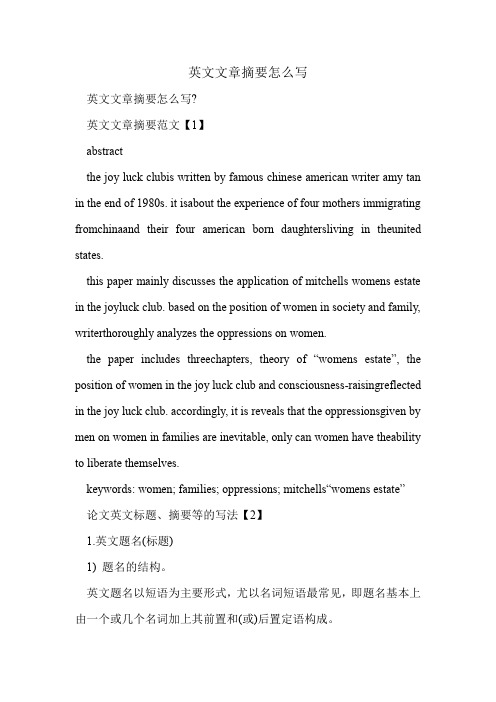
英文文章摘要怎么写英文文章摘要怎么写?英文文章摘要范文【1】abstractthe joy luck clubis written by famous chinese american writer amy tan in the end of 1980s. it isabout the experience of four mothers immigrating fromchinaand their four american born daughtersliving in theunited states.this paper mainly discusses the application of mitchells womens estate in the joyluck club. based on the position of women in society and family, writerthoroughly analyzes the oppressions on women.the paper includes threechapters, t heory of “womens estate”, the position of women in the joy luck club and consciousness-raisingreflected in the joy luck club. accordingly, it is reveals that the oppressionsgiven by men on women in families are inevitable, only can women have theability to liberate themselves.keywords: women; families; oppressions; mitchells“womens estate”论文英文标题、摘要等的写法【2】1.英文题名(标题)1) 题名的结构。
描述性英文作文

描述性英文作文篇一:说明原因性英语作文五、说明原因型My View on Off-campus Room Renting1. 很多大学生在校外租房住2. 学生校外租房的主要原因3. 校外租房的利弊My View on Off-campus Room RentingNo one can have failed to notice the phenomenon that nowadays an increasing number students choose to rent rooms or apartments off campus instead of living in dormitories on campus.A number of factors account for the phenomenon mentioned above, but the following might be the critical ones. Firstly/ In the first place, it seems the best solution for students who cannot adjust to dormitory life and show incompetence in roommate relations. Secondly/In the second place, many a senior lives outside to make better preparations for the thesis or examination. Finally/ Last but not least, room renting means freedom to some students, who hate to be regulated by the school rules.It's obvious that living off campus provides someconvenience, more favorable conditions, for example. However,the disadvantages far outweigh the advantages in this case. Above all, room renting is money consuming for students. And escape is never the correct way out of maladjustment. Besides,too much freedom may result in indulgence and idleness. Therefore, we must think twice when considering living off campus.篇二:用英语描述人的性格特征如何用英语来描述一个人的性格特征What are the words used for discribing a person's character? Selfish自私 1 : concerned excessively or exclusively with oneself : seeking or concentrating on one's own advantage, pleasure, or well-being without regard for others2 : arising from concern with one's own welfare or advantage in disregard of others a selfish act3 : being an actively replicating repetitive sequence of nucleic acid that serves no known function selfish DNA also : being genetic material solely concerned with its own replication selfish genesUnethical, Moral (Immoral), Tender, Affectionate , Self obsessed., Dim witted, Sweet, Sarcastic, Passionate, Simple minded, Sardonic, Dull, Strange, Unorthodox, Wild, Crazy, Uealistic, Shallow, Cruel, Evil, Loving, Humorous, Gentle, articulate, Domineering, Humble (modest), Charming, Ice cold, unfeeling, Sincere, enthusiastic,Optimistic, Pessimistic, loyal, honest, sneaky, sly, unjust, humorous, kind, softspoken, passive, aggressive, sweet, caring, genuine, loving, fair, open, compassionate, conceited, stubborn, motivated, lazy, Clumsy, Soft (heart, skin, tummy), Rouser, Baggageless, Low Maintenance, List Maker, Annoyingly Organized to Outsiders, Aggressive Driver, Flexible, Basket Case , friend, daughter, Bad Hugger, Geographically Curious, Casual, Loud, Multi-Tasker to a fault, Anxious, Colorful, Articulate, Valorous, Kind, Caring, Honorable, Heroic, Helpful, Generous, Magnanimous , Strong-willed, Creative, Intelligent, Curious, Diplomatic, Soulful1. 1 egotistic, 2 initiative, 3 ener(本文来自: 千叶帆文摘:描述性英文作文)getic, 4 informed/knowledgable, 5 compassoinate, 6 considerate, 7 witty, 8 astute, 9 foolish, 10 warm (soft), 11 delicate, 12 genuine, 13 original, 14 truthful, 15 bold, 16 daring, 17 meek, 18 rigid, 19 apathetic, 20 regretful, 21 eager, 22 intense, 23 inventive, 24 thoughtful, 25 apprehensive, 26 watchful, 27 aggitated, 28 distracted, 29 loving, 30 anxious, 31 euphoric, 32 blissful, 33 bothered, 34 dynamic2. egotistical, intelligent, practical, ignorant, grandiose, uestraigned, extravagant, atheletic, preoccupied, sadistic, wanton, lusty篇三:如何描写人物英语作文如何描写人物此类作文是记叙文的一种, 以人物为中心组织材料, 围绕人物来写。
中英文长摘要规范

长摘要规范1、文摘篇幅:中文长文摘字数要求在1000字以上。
英文长文摘内容与中文对应。
2、文摘结构:(1)目的——研究、研制、调查等的前提、目的和任务,所涉及的主题范围;(2)方法——所用的原理、理论、条件、对象、材料、工艺、结构、手段、装备、程序等;(3)结果——实验的、研究的结果,数据,被确定的关系,观察结果,得到的效果,性能等;(4)结论——结果的分析、研究、比较、评价、应用,提出的问题,今后的课题,假设,启发,建议,预测等;(5)其他——不属于研究、研制、调查的主要目的、方法和结论,但具有创新性和学术交流价值的重要内容。
3、文摘内容文摘要突出作者原创性工作,应排除本学科领域已成为常识的内容,不得简单重复题名中已有的信息,也不得与引言相混。
文摘要着重反映出文章的创新、独到之处,尽量删除背景信息或过去的研究,只叙述新信息和发现、最关键的数据等。
另一方面,不得将未来计划等原文献本身未含的信息或主张写入文摘之内。
文字简洁,取消不必要的字句(例如:In this paper、in detail、briefly、mainly、not only… but also等)尽量简化一些措辞和重复的单元。
例如,用“at 250℃ to 300℃”代替“at a temperature of 250℃ to 300℃”、用“the results show …”代替“from the experimental results, it can be concluded that”4、避免主观评价一般不要对论文做自我主观评价,尤其是不要自己标榜自己的研究结果。
避免使用“首次”、“第一”或“比较好”等自我评价的词语和“具有……的意义”、“奠定了……基础”、“具有……参考价值”、“对……大有帮助”、“首次实现了...”等句式。
避免出现“本文所谈的有关研究工作是对过去老工艺的一个极大的改进”、“经检索尚未发现与本文类似的文献”、“To our knowledge, there is as yet no paper in the open literature”等表达。
科技论文英文摘要模板
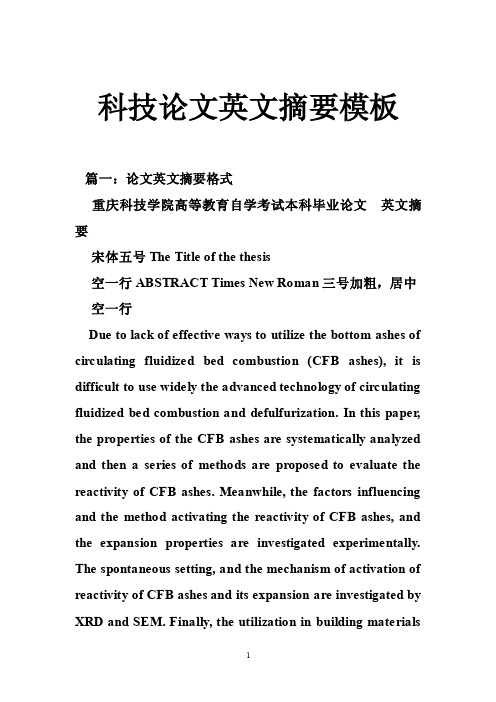
科技论文英文摘要模板篇一:论文英文摘要格式重庆科技学院高等教育自学考试本科毕业论文英文摘要宋体五号The Title of the thesis空一行ABSTRACT Times New Roman三号加粗,居中空一行Due to lack of effective ways to utilize the bottom ashes of circulating fluidized bed combustion (CFB ashes), it is difficult to use widely the advanced technology of circulating fluidized bed combustion and defulfurization. In this paper, the properties of the CFB ashes are systematically analyzed and then a series of methods are proposed to evaluate the reactivity of CFB ashes. Meanwhile, the factors influencing and the method activating the reactivity of CFB ashes, and the expansion properties are investigated experimentally. The spontaneous setting, and the mechanism of activation of reactivity of CFB ashes and its expansion are investigated by XRD and SEM. Finally, the utilization in building materialsof CFB ashes is studied.The properties of CFB ashes show it is difficult to utilize CFB ashes in building materials, however reasonable using its properties is possible in building materials. As concrete fine aggregate, it can improve structure of interface between aggregates and cement paste for its reactivity, then can increase the concrete flexural strength. As concrete additive can fully activate the reactivity, and can partly compensate the concrete shrinkage. Because of performance of the fresh concrete and durability, it is better to use it with FA. They both influence performance of the fresh concrete. It can produce CFB ashes-fly ash mortar used indoors and CFB ashes-fly ash-clinker mortar used outdoors with low shrinkage by using the cement and expansion of CFB ashes. CFB ashes mixed with lime, FA or cement, can be used for roadbed mixture in road Times New Roman小四号Keywords:Circulating Fluidized Bed Combustion, CFB Ashes, Reactivity, Expansion,Times New Rom小四号Times New Roman加粗小四号Ⅱ篇二:科技论文英文摘要的编写及翻译科技论文英文摘要的编写及翻译随着科学技术的日新月异,我国在科技领域取得了越来越多的成就,受到更多国际同行的关注。
科技词汇(读者文摘英文版)

科技1.antioxidant ['ænti'ɔksidənt] n. 防[抗]氧化剂(用做食物防腐剂); 防老化剂(用于塑料)2.meltdown ['meltdaun] n. 融化, 熔毁熔体[美俚]灾难过程);3.scope [skəup] n. (活动或观察的)范围, 眼界, 视野, 地域;4.endurance [in'djurəns] n. 忍耐(力) 耐久(性), 持久(性) 持续[续航]时间强度, 抗磨度5.antenna [æn'tenə] n. (pl. antennas )【无】天线(英国一般用aerial) 触角, 触须卷须,6.gauge [ɡedӡ] n.(=[美] gage[^eidV])标准规格[度量, 尺寸];度容量, 限度, 范围7.ingredient [in'ɡri:diənt] n, 配料成分, 要素8.infest [in'fest] vt. (害虫、盗贼等)大批出没; 侵扰9.magnet ['mæɡnit] n. 磁铁[体, 石]有吸引力的人[物]10.loophole ['lu:phəʊl] n. 漏洞(墙上的)射击孔,窥视孔11.transp arency [træns'pεərənsi] n.透明性[度]; 透明物体12.silicone ['silikəun] n.【化】硅有机树脂硅黄; 聚硅酮13.hypothermic [,haɪpəʊ`θз:mɪk] adj.低体温的, 体温过低的14.spectrum ['spektrəm] n.【物】谱, 光[波, 能, 质]谱\范围, 领域, 系列15.hydraulics ['hai'drɔ:liks] n[pl.][用作单或复]水力学16.evaporate [i'væpəreit] vt.使蒸发; 使浓缩, 使脱水;17.coddle['kɔd(ə)l] (在低于沸点的水中)煮(蛋等)溺爱;娇养(= mollycoddle)18.detective n.侦探a. 侦探的19.pharmacist ['fɑ:məsɪst]n.制药者\药商;药剂师20.medication[͵medi'kei∫ən]n.药物疗法; 加入药物; 药物处理,药物, 药剂21.wax n. 蜡, 蜡状物, 一阵发怒, 增加, (月亮)渐盈月亮渐满22.mimic ['mimik]adj. 模仿的, 摹拟的, 假的; 伪装的23.erode [i'rəud] vt. 侵蚀, 腐蚀24.veterian 兽医25.sodium化】钠(11号元素, 符号Na)26.diabetes [͵daiə'bi:ti:z,-ti:s]n.(=diabetes mellitus) 【医】糖尿病27.calory 【医】卡[路里](热量单位)28.planetarium [plænɪ'teərɪəm]n.-riums 或-ria 天文馆天象仪29.plastic surgeon 整形外科医生30.reinforcement[͵ri:in'fɔ:smənt]n.增强, 加固; 强化物; 补给品, [常用复]加固物31.congestion [kən'dӡest∫ən]n.【医】充血(交通的)拥挤;(货物的)充斥;(人口)稠密32.steroid ['stiərɔid]n. [俗]类固醇33.inhaler [ɪn'heɪlə(r)]n.吸入器34.formula['fɔ:mjulə]n.(pl. formulas, formulae [-li:])公式, 方程式计算式准则;方案【医】配方35.hormone ['hɔ:məun]n.【生化】荷尔蒙, 激素, 内分泌36.snapshot n.快照, 快相,简短描述,一晃眼37.solar cooker n. 太阳灶38.wireless n. 无线(电报)的;无线(电话)的39.windshield 〈汽车〉风挡玻璃40.lightbulb n. 灯泡41.mucus n. 粘液42.Contaminant [kən'tæminənt] n. 污染物(质),放射性污染43.Anthrax n. 炭疽【医】炭疽(脾脱疽)44.Plague [pleiɡ] n. 瘟疫, 黑死病; [the plague]鼠疫天灾, 灾害, 祸患45.Mechanisms 机制46.Biological a. 生物学的【医】生物学的47.Smallpox ['smɔ:lpɔks] n. 〈医〉天花48.Sensor ['sensə] n. 传感器; [装置]探测器49.Airborne ['εəbɔ:n] adj. 空中的航空的, 空动的, 机载的, 风成的; 空降的50.Sample ['sæmpl] n.样品, 货[试]样; 标本; 实例; 榜样51.Petard [pe'tɑ:d] n. (古代攻城等用的)炸药包大花炮52.Vibrant ['vaibrənt] adj. 振动的, 振荡的发颤音的, 振响, 有活力的; 激动的53.Morph [mɔf] n. (动植物的)变种, 变体; 语子, 语素形式, 形素54.Lithium ['liθiəm] n. 【化】锂( 3号元素, 符号Li)55.Abnormality n. 反常, 畸形, 变态56.Coauthor [kəu'ɔ:θə] n. 合著者,合作者,共同研究者57.Wrinkle n. 皱纹, 妙计, 方法, 技巧58.Unfathomable [ʌn'fæðəməbl] adj. 深不可测的, 无底的难解的59.indicator ['indikeitə] n. 指示者; 指示物, 指示器; 指针; 示高计, 指压器。
英文摘要怎么写 - 副本

17
Here is a six-step process for writing summaries:
1. Select the essential points from each section of the document by underlining and numbering them. 2. Ignore any repetition or lists
是个总结就可以称之为Summary
6 Βιβλιοθήκη bstract abstract = 摘要(学术界/ 论文用) 不可用图表和公司
Summary
summary = 摘要/总结 (general public 用) 可插入图表和公式
独立于正文前
数十到300字左右
正文结尾,或每章节后
5
2.提要(或简介),即英文的Summary :既然 称之为提要,即包含提炼和要点两个方面。 在科技文献和教科书中,提要强调对研究课 题内容的概括,比如实验内容、目的、研究 的展望等方面的简述。提要对字数的要求比 较灵活,可长可短。既可以图文并茂,也可 以广征博引。既可放在文前,也可以置于文 后。和摘要Abstract 相比,提要 Summary 更 普及常用,不论是在学术界还是日常交流中 都会经常出现
19
Sample 1 When he stopped at a village, the motorist was told that a queen bee must be hidden in his car as there were thousands of bees nearby. On learning his, the man realized that the only way to escape would be to drive away as quickly as possible.
文摘(英文文献)
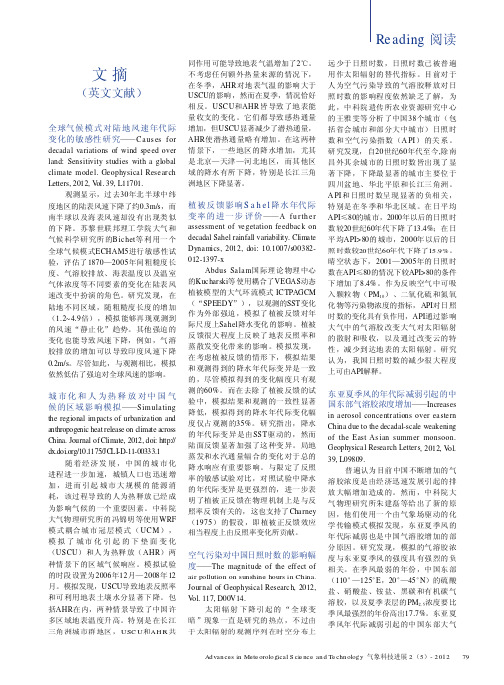
Reading 阅读M S T y 气象科技进展(5)文摘(英文文献)全球气候模式对陆地风速年代际变化的敏感性研究——Caus es fordecadal variations of wind speed over land:Sensitivity studies with a global climate model.Geophysical Research Letters,2012,V ol.39,L11701.观测显示,过去30年北半球中纬度地区的陆表风速下降了约0.3m/s ,而南半球以及海表风速却没有出现类似的下降。
苏黎世联邦理工学院大气和气候科学研究所的Bichet 等利用一个全球气候模式ECHAM5进行敏感性试验,评估了1870—2005年间粗糙度长度、气溶胶排放、海表温度以及温室气体浓度等不同要素的变化在陆表风速改变中扮演的角色。
研究发现,在陆地不同区域,随粗糙度长度的增加(1.2~4.9倍),模拟能够再现观测到的风速“静止化”趋势。
其他强迫的变化也能导致风速下降,例如,气溶胶排放的增加可以导致印度风速下降0.2m/s 。
尽管如此,与观测相比,模拟依然低估了强迫对全球风速的影响。
城市化和人为热释放对中国气候的区域影响模拟——Simulatingthe regional impacts of urbanization and anthropogenic heat release on climate across China.Journal ofClimate,2012,doi:/10.1175/JCLI-D-11-00333.1随着经济发展,中国的城市化进程进一步加速,城镇人口也迅速增加,进而引起城市大规模的能源消耗,该过程导致的人为热释放已经成为影响气候的一个重要因素。
中科院大气物理研究所的冯锦明等使用WRF 模式耦合城市冠层模式(UCM ),模拟了城市化引起的下垫面变化(USCU )和人为热释放(AHR )两种情景下的区域气候响应。
- 1、下载文档前请自行甄别文档内容的完整性,平台不提供额外的编辑、内容补充、找答案等附加服务。
- 2、"仅部分预览"的文档,不可在线预览部分如存在完整性等问题,可反馈申请退款(可完整预览的文档不适用该条件!)。
- 3、如文档侵犯您的权益,请联系客服反馈,我们会尽快为您处理(人工客服工作时间:9:00-18:30)。
英文文摘Four-stage-engine and Two-stage-engine Operation The actions taking place in the engine cylinder can be divided into four stages, or strokes.“Stroke”refers to piston movement;a stroke occurs when the piston moves from one limiting position to the other. The upper limit of piston movement is called TDC(top dead center). The lower limit of piston movement is called BDC (bottom dead center). A stroke is piston movement from TDC to BDC or from BDC to TDC. In other words, the piston completes a stroke each time it changes its direction of motion.Where the entire cycle or events in the cylinder requires four strokes (or two crankshaft revolutions), the engine is called a four-stroke-cycle engine, or a four-cycle engine. The four piston strokes are intake, compression, power, and exhaust.Intake stroke. On the intake stroke, the intake valve has opened, the piston is moving downward, and a mixture of air and vaporized gasoline is entering the cylinder through the valve port. The mixture of air and vaporized gasoline is delivered to the cylinder by the fuel system and carburetor.Compression stroke. After the piston reaches BDC, or the lower limit of its travel, it begins to move upward. As this happens, the intake valve closes. The exhaust valve is also closed, so that the cylinder is sealed. The exhaust valve is also closed, so that the cylinder is sealed. As the piston moves upward(pushed now by the revolving crankshaft and connecting rod), the air-fuel mixture is compressed. By the time the piston reaches TDC, the mixture has been compressed to as little as one –tenth of itsoriginal volume, or even less. This compression of the air-fuel mixture increases the pressured, not only does the pressure in the cylinder go up, but the temperature of the mixture also increases.Power stroke. As the piston reaches TDC on the compression stroke, an electric spark is produced at the spark plug. The ignition system delivers a high-voltage surge of electricity to the spark plug to produce the spark. The spark ignites, or sets fire to, the air-fuel mixture. It now begins to burn very rapidly, and the cylinder pressure increases to as much as 3-5 MPa or even more. This terrific push against the piston forces it downward, and a power impulse is transmitted through the connecting rod to the crankpin on the crankshaft. The crankshaft is rotated as the piston is pushed down by the pressure above it.Exhaust stroke. As the piston reaches BDC again, the exhaust valve opens. Now, as the piston moves up on the exhaust stroke, it forces the burned gases ort of the cylinder through the exhaust-valve port. Then, when the piston reaches TDC, the exhaust valve closes and the intake valve opens. Now, a fresh charge of air-fuel mixture will be drawn into the cylinder as the piston moves down again to-ward BDC, The above four strokes are continuously repeated.In the four-stroke-cycle engine, already discussed in Lesson 1、2, the complete cycle of events requires four piston strokes (intake, compression, power, and exhaust). In the two-stroke-cycle, or two-cycle, engine, the intake and compression strokes and the power and exhaust strokes are in a sense combined. This permits the engine to produce a power stroke every two piston strokes, or every crankshaft rotation.In the two-cycle engine, the piston acts as a valve, clearing valve ports in the cylinder wall as it nears BDC.A fresh air-fuel charge enters through the intake port, and the burned gases exit through the exit through the exhaust port. The complete cycle of operation is as follows: As the piston nears TDC, ignition takes place. The high combustion pressures drive the piston down, and the thrust through the connecting rod turns the crankshaft. As the piston nears BDC, it passes the intake and exhaust ports in the cylinder wall. Burned gases, still under some pressure, begin to stream ort through the exhaust port. At the same time, the intake port, now cleared by the piston, begins to deliver air-fuel mixture, under pressure, to the cylinder. The top of the piston is shaped to give the incoming mixture an upward movement. This helps to sweep the burned gases ahead and out through the exhaust port.After the piston has passed through BDC and starts up again, it passes both ports, thus sealing them off. Now the fresh air-fuel charge above the piston is compressed and ignited. The same series of events takes place again and continue as long as the engine runs.We mentioned that the air-fuel mixture is delivered to the cylinder under pressure. In most engines, this pressure is put on the mixture in the crankcase. The crankcase is sealed except for a leaf, or reed, valve at the bottom. The reed valve is a flexible, flat metal plate that rests snugly against the floor of the crankcase. There are holes under the reed valve that connect to the engine carburetor. When the piston is moving up, a partial vacuum is produced in the sealed crankcase. Atmospheric pressure lifts thereed valve off the holes, and air-fuel mixture enters the crankcase. After the piston passes TDC and starts down again, pressure begins to build up in the crankcase. This pressure closes the reed valve so that further downward movement of the piston compresses the trapped air-fuel mixture in the crankcase. The pressure which is built up on the air-fuel mixture then causes it to flow up through the intake port into the engine cylinder when the piston moves down far enough to clear the intake port.The two-stroke engine is not only very simple but gives nearly twice the power of a four stroke engine from a cylinder of given size, but it is wasteful of gasoline, as some mixture inevitably finds its way into the exhaust system on the combines intake/exhaust stroke, and there are always some combustion products left in the cylinder which reduce the rapid burning of the fuel. This kind of engine is always used in motorcycles.中文翻译四行程发动机和二行程发动机的工作过程发动机气缸内的工作过程,可以分为四个阶段,或行程。
